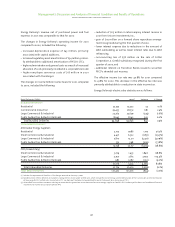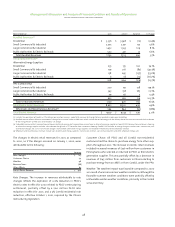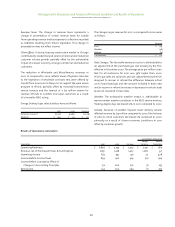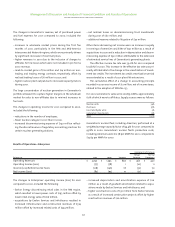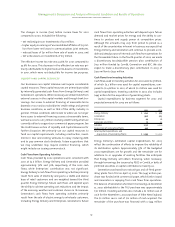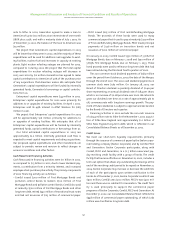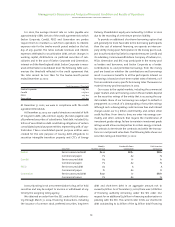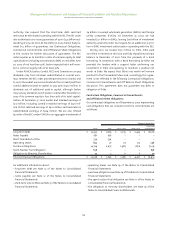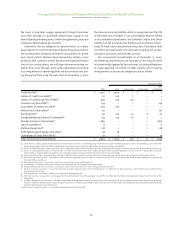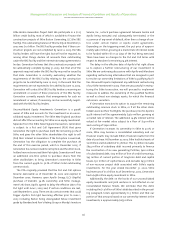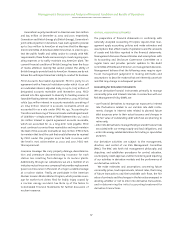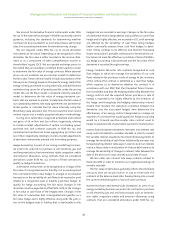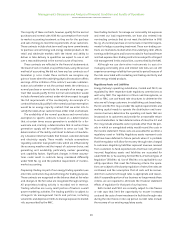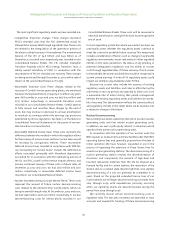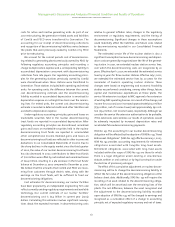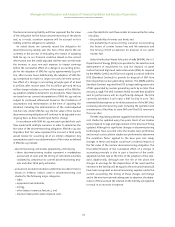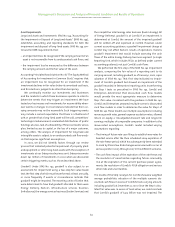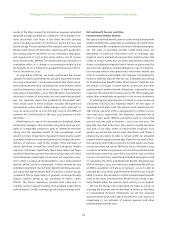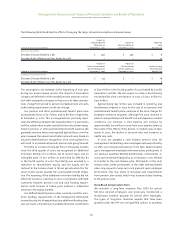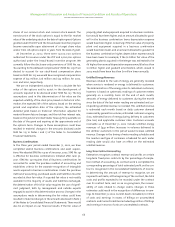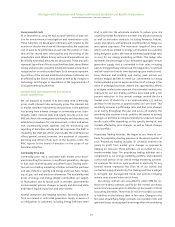ComEd 2002 Annual Report Download - page 59
Download and view the complete annual report
Please find page 59 of the 2002 ComEd annual report below. You can navigate through the pages in the report by either clicking on the pages listed below, or by using the keyword search tool below to find specific information within the annual report.
57
Generation’s equity investment in AmerGen was $160 million
and $95 million at December 31, 2002 and 2001, respectively.
Generation and British Energy plc (British Energy), Generation’s
joint venture partner in AmerGen, have each agreed to provide
up to $100 million to AmerGen at any time that the Manage-
ment Committee of AmerGen determines that, in order to pro-
tect the public health and safety and/or to comply with NRC
requirements,these funds are necessary to meet ongoing oper-
ating expenses or to safely maintain any AmerGen plant. The
current financial condition of British Energy has been the focus
of media attention recently. We cannot predict the ability of
British Energy to provide funds to AmerGen.However,we do not
believe this will impact AmerGen’s ability to conduct its business.
PECO Accounts Receivable Agreement. PECO is party to an
agreement with a financial institution under which it can sell
an undivided interest, adjusted daily, in up to $225 million of
designated accounts receivable until November 2005. PECO
entered into this agreement to diversify its funding sources at
favorable floating interest rates.At December 31, 2002,PECO had
sold a $225 million interest in accounts receivable,consisting of
an $164 million interest in accounts receivable, which we
accounted for as a sale under SFAS No. 140, “Accounting for
Transfers and Servicing of Financial Assets and Extinguishment
of Liabilities—a Replacement of FASB Statement No.125,” and a
$61 million interest in special agreement accounts receivable,
which we accounted for as a long-term note payable. PECO
must continue to service these receivables and must maintain
the level of the accounts receivable at $225 million. If PECO fails
to maintain that level,the cash that would otherwise be received
by PECO under this program must be held in escrow until
the level is met. At December 31, 2002 and 2001, PECO met
this requirement.
Insurance Coverage. We carry property damage, decontamina-
tion and premature decommissioning insurance for each
station loss resulting from damage to its nuclear plants.
Additionally, through our subsidiaries, we are a member of an
industry mutual insurance company that provides replacement
power cost insurance in the event of a major accidental outage
at a nuclear station. Finally, we participate in the American
Nuclear Insurers Master Worker Program,which provides cover-
age for worker tort claims filed for bodily injury caused by
a nuclear energy accident. See Note 19 of the Notes to
Consolidated Financial Statements for further discussion of
nuclear insurance.
critical accounting estimates
The preparation of financial statements in conformity with
Generally Accepted Accounting Principles requires that man-
agement apply accounting policies and make estimates and
assumptions that affect results of operations and the amounts
of assets and liabilities reported in the financial statements.
Management discusses these estimates and assumptions with
its Accounting and Disclosure Governance Committee on a
regular basis and provides periodic updates to the Audit
Committee of the Board of Directors on management decisions.
Management believes that the following areas require signi-
ficant management judgment in making estimates and
assumptions to describe matters that are inherently uncertain
and that may change in subsequent periods.
Accounting for Derivative Instruments
We use derivative financial instruments primarily to manage
commodity price and interest rate risks. In connection with our
Risk Management Policy (RMP), we:
– use financial derivatives to manage our exposure to interest
rate fluctuations related to our variable rate debt instru-
ments, changes in interest rates related to planned future
debt issuances prior to their actual issuance and changes in
the fair value of outstanding debt which we are planning to
retire early,
– enter into derivatives to manage the physical and financial risks
associated with our energy supply and load obligations, and
– enter into energy related derivatives for trading or speculative
purposes.
Our derivative activities are subject to the management,
direction, and control of our Risk Management Committee
(RMC). The RMC sets forth risk management philosophy and
objectives, and establishes procedures for control, valuation,
counterparty credit approval,and the monitoring and reporting
of our activities in derivative markets and the performance of
our derivative contracts.
We make estimates and assumptions concerning future
commodity prices, load requirements, interest rates, the timing
of future transactions and their probable cash flows, the fair
value of contracts and the changes in the fair value we expect in
deciding whether or not to enter into derivative transactions,
and in determining the initial accounting treatment for
derivative transactions.
Management’s Discussion and Analysis of Financial Condition and Results of Operations
exelon corporation and subsidiary companies


